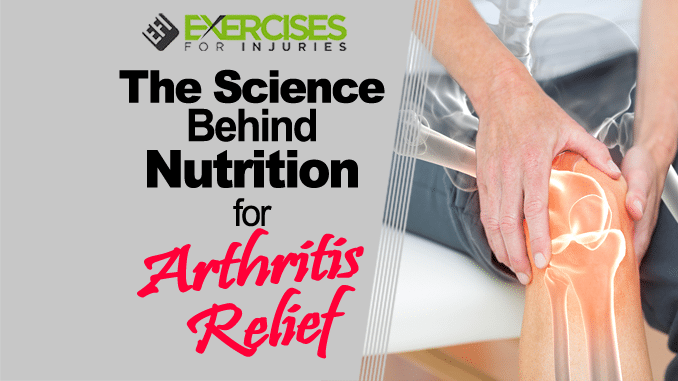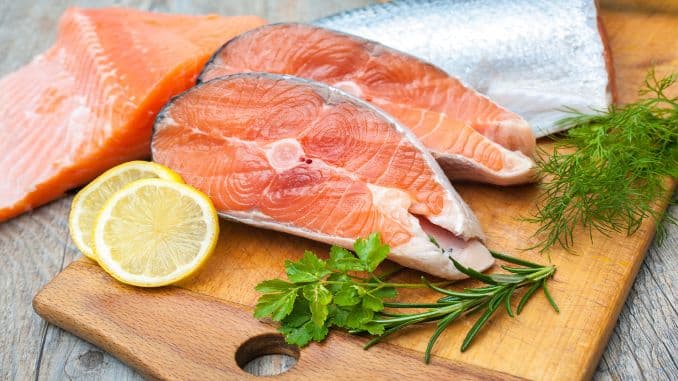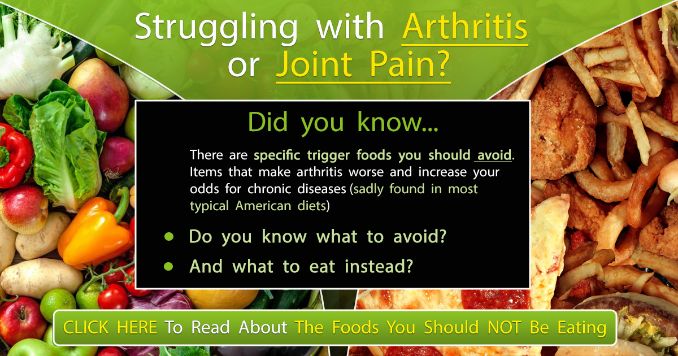
Most people think of arthritis in terms of physical signs and symptoms — your bones creak and joints crack. We tend to think of physical solutions to arthritis also. Do you need a joint replacement or a brace? Whatever the case, arthritis is a complex problem and metabolic factors should also be considered. Let’s take a look at how nutrition may influence arthritis and its associated symptoms.
What Kind of Arthritis?
When we say “arthritis,” we refer to a wide range of disorders. In fact, there are over 100 different forms of arthritis and related diseases. The most common types are:
- Osteoarthritis (OA)
- Rheumatoid arthritis (RA)
- Psoriatic arthritis (PsA)
- Fibromyalgia
- Gout
All of these have different mechanisms of action, so any type of nutritional approach to treatment may vary between them. In this article, we’ll focus on osteoarthritis since it’s the most common and more likely associated with exercise and injury.
Osteoarthritis is the Most Common
By far the most common form of arthritis is osteoarthritis. This type of arthritis occurs due to “wear and tear” as cartilage in the joints breaks down. OA is more common in older adults, and people who have had injuries to their joints are also at higher risk. In time, your cartilage may wear down to the point where bone grinds directly against bone.
The level of pain varies widely among those with OA. For some, the pain is mild or occasional, for others, pain may be very severe and even disabling. The risk factors for developing osteoarthritis are:
- Older age: Your risk goes up as you age
- Sex: More common in women
- Obesity: Extra body weight increases joint stress; also, adipose (fat) tissue produces proteins that may cause inflammation in and around joints
- Past injuries: Injuries from sports or accidents can increase OA risk; even old “healed” joint injuries can later contribute to arthritis risk
- Occupation:- Repetitive movement and stress on any joint may lead to osteoarthritis
- Genetics: You can inherit a tendency to have OA
- Bone deformities: People born with joint or cartilage problems have an increased risk
Nutritional Aspects of OA Treatment
If you look carefully at the risk factors for osteoarthritis, many of them don’t have much of a metabolic component. However, something about fat tissue gives us a hint about how nutrition might influence osteoarthritis. The key is inflammation.
Recent research suggests that osteoarthritis is as much a metabolic disease as it is a physical one. The theory is that lipids (fats) somehow contribute to cartilage destruction. This might partly explain why this form of arthritis is more common in women. Females have a higher concentration of body fat on average compared to men.
Good Fat for Osteoarthritis
Although it may sound counterintuitive, there is actually one type of fat that may benefit those suffering from OA — omega-3 fatty acids. The most important omega-3s are eicosapentaenoic acid (EPA) and docosahexaenoic acid (DHA), which are found in fish, and alpha-linolenic acid (ALA), which is found in nuts and seeds.
The reason omega-3 fatty acids may help prevent or treat OA is that these substances decrease inflammation. In some people, X-rays of their joints show arthritic changes, but they have no pain. Instead, inflammation causes pain, and it may also contribute towards faster joint space damage.
Foods rich in omega-3 fatty acids include:
- Anchovies
- Bluefish
- Herring
- Mackerel
- Salmon
- Sardines
- Sturgeon
- Lake trout
- Tuna
- Walnuts
- Flaxseed and flaxseed oil
- Canola oil
- Soybeans
Be careful as some fish may have high levels of mercury and other toxins. Try to limit your consumption of mackerel, wild swordfish, tilefish and shark. Also, farm-raised fish of any kind may be higher in contaminants. Wild-caught fish are best.
How About Omega-3 Supplements?
Nutrition for Arthritis: If at all possible, it’s always best to go for a natural source of any nutrient or vitamin. For instance, wild-caught salmon is a great source of omega-3s. Two servings of fatty fish per week should be enough to meet your omega-3 needs. However, in some cases, supplements may be useful.
The typical recommended dose is 1,000 milligrams of omega-3 fish oil per day in supplement form. Try to buy fish oil in triglyceride form that also contains antioxidants or essential oils. This combination helps prevent the supplement from becoming rancid or stale. If you are going to take a supplement, make sure you consult with your doctor first.
Other Benefits of Omega-3 Fatty Acids
As you might imagine, the anti-inflammatory benefits of omega-3s don’t stop at your joints. Other research has shown that this nutrient may also benefit or treat:
- High triglycerides: A type of cholesterol that can increase heart disease risk
- Rheumatoid arthritis: Another form of arthritis; omega-3s may help medications for this condition be more effective
- Mood disorders: People that consume a lot of fatty fish seem to have less incidence of depression; omega-3s may help partially relieve depression and bipolar disorder
- Infant development: DHA may play a role in eye and brain development
- Asthma: Anti-inflammatory properties of omega-3s may reduce asthma symptoms
- Attention-deficit/hyperactivity disorder (ADHD): Omega-3s may help improve learning in those with ADHD
- Alzheimer’s disease: Research is ongoing about the possibility that omega-3s can prevent dementia
Other Nutritional Factors Affecting Osteoarthritis
Nutrition for Arthritis: High cholesterol has also been associated with osteoarthritis. This may be related to excess body fat. However, the link probably goes beyond body weight issues. Currently, nobody recommends taking a cholesterol-lowering medication to treat arthritis. Lowering your body weight, however, may lower your cholesterol and reduce stress on your joints.
Another study revealed that low vitamin D might be associated with worsening OA. Vitamin D is synthesized by your skin when exposed to the sun. You don’t want to overdo sun exposure, but 10 to 15 minutes of direct sunlight twice a week will help keep your vitamin D levels optimal. You can also get vitamin D from fatty fish, beef liver, cheese, egg yolks and fortified milk sources.
Finally, vitamin K deficiency has also been linked to the appearance of osteoarthritis. This makes sense since vitamin K is involved in cartilage metabolism. The best sources of vitamin K are:
- Green leafy vegetables
- Natto (fermented soy)
- Spring onions (scallions)
- Brussels sprouts
- Cabbage
- Broccoli
- Prunes
- Cucumbers
- Dried basil
Consider Turmeric
Nutrition for Arthritis: Turmeric is a spice used in many curry dishes, and it’s a powerful anti-inflammatory agent. In Japan, research showed that turmeric reduces inflammatory markers like interleukin (IL)-6. This inflammatory cytokine is involved in rheumatoid arthritis. Turmeric can be used as a spice for cooking, and it also comes in supplement form. A commonly recommended dose is 1,000 mg per day.
What About Glucosamine?
Nutrition for Arthritis: Glucosamine is a component of cartilage. Studies have been mixed about the benefits of glucosamine supplements for treating arthritis. The most natural way to consume glucosamine is by preparing a bone broth. Liquid supplements are easier for the body to absorb than a powder.
Don’t Forget to Avoid These Things
Nutrition for Arthritis: If we follow the same logic that inflammation makes arthritis symptoms worse, then it makes sense to avoid foods that increase inflammation. This means you should minimize your intake of or avoid completely the following:
- Sugar: This includes table sugar and sweetened foods, drinks, candy or desserts; anything on the label that says fructose, glucose, sugar, dextrose, sweetener, malt, syrup or fruit juice are things to avoid
- Certain oils: Hydrogenated oil, cottonseed oil and canola oil may increase inflammation while olive oil is a healthier option and may even reduce inflammation
- Grains: Gluten, flour products and wheat products may lead to worsening arthritis
Conclusion
Even though osteoarthritis is associated with physical signs and symptoms, a metabolic component is certainly part of the picture. If you follow the guidelines in this article, combined with keeping your weight down, you might find yourself with a lot less pain and more mobility.
Looking to decrease arthritis joint pain? Make sure to check out Cooking for Joint Health, here!



